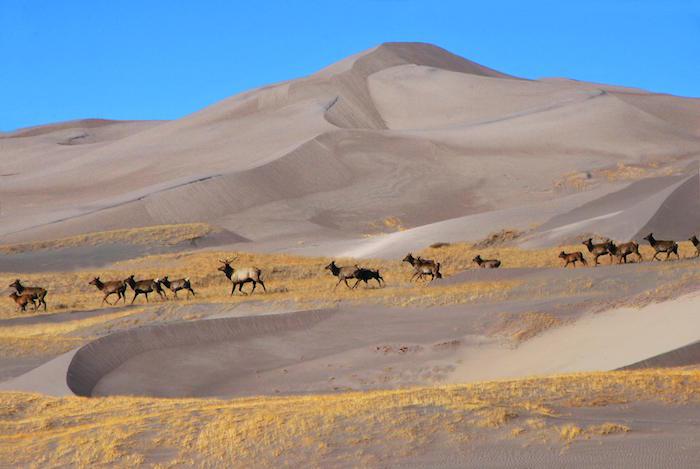
Great Sand Dunes National Park in Colorado might not come immediately to mind for fall wildlife viewing, but it's a good spot to try./NPS
While all national parks have abundant wildlife throughout the year, fall is prime time. Birds and animals are on the move, preparing for winter, and courting. They’re busy and plentiful.
In the Rocky Mountains, elk are retreating from the high country before winter’s snows set in. In Yellowstone, Glacier, and Grand Teton as they head to the lower river valleys, the wolves follow them, and are often spotted. You’ll hear the ear-piercing bulging of bull elk as they work to build their harems. It starts as a shrill, rising whistle, then ends in a guttural grunt. You won’t forget that sound for the rest of your life.
Bugling elk are best seen—and heard—shortly before sunset, and shortly after sunrise. Bison, another icon of the parks, are seen throughout the day in parks where they live.
In the mountainous parks of the East—Shenandoah, the Blue Ridge Parkway, and Great Smoky to name just three—black bears are drawn to the tasty fruit of long-abandoned apple orchards and ripe berries for sweet snacks; anything to put that fat on for the winter.
Across the National Park System the birds are migrating. Raptors soar high and songbirds are flying south to their wintering grounds in Central and South America.
We’ve provided links, when available, to specific parks’ websites where you can download birding and animal lists. These sites frequently have suggestions on where to look for wildlife by the season.
Here’s a region-by-region overview of where to go this fall to see, and hear, wildlife throughout the National Park System:
East
Acadia National Park, Maine
Best bets: Raptors
Scan the skies over Acadia and you won’t go home disappointed as you watch for migrating birds. The mountains of Mount Desert Island, anchored just off the coast of Maine, are a great spot to spy them.
The park’s annual Hawk Watch season gets under way in late August and runs into October. Thousands of birds of prey, including falcons, hawks, ospreys and eagles, migrate through Acadia’s airspace during autumn. Park visitors join Hawk Watch to see and learn more about these fascinating birds.
During the migration, weather permitting, park rangers and volunteers atop Cadillac Mountain will help you spot and identify birds passing by, and provide natural history information on raptors and related topics. Frequently sighted species include Sharp-shinned hawks, American kestrels, and Broadwinged hawks.
Resources:
Blue Ridge Parkway, Virginia/North Carolina
Best bets: Raptors, black bears, white-tail deer
The Blue Ridge Parkway follows the Appalachian ridges for 469 miles, and you can spot birds the entire way. They soar on the thermals pushed up by the mountains as they head south.
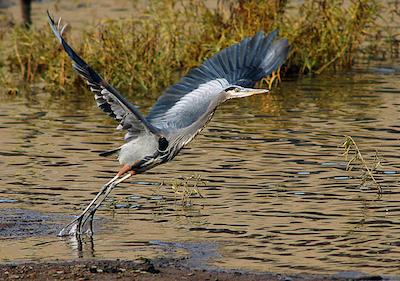
Wildlife to be seen at New River Gorge National River in West Virginia include Great blue herons/NPS, Gary Hartley
In North Carolina, Mills River Overlook at Milepost 404.5 is a popular place to scan the sky for hawks. At Milepost 364.1, walk up Craggy Pinnacle and see Broad-winged, Red-tailed, and Red-shouldered hawks, Cooper’s hawks and Sharp-shinned hawks.
The base of Mount Mitchell at Ridge Junction Overlook, Milepost 355.3, at Black Mountain Gap, is one of the best spots in the Blue Ridge to watch the migration of warblers and other passerines. Hawks also pass through, heading south about the third week of September.
Continuing north on the Parkway, Mahogany Rock in Virginia at Mile Post 235 has a long history of excellent hawk watching in September and October.
Resources:
Great Smoky Mountains National Park, Tennessee/North Carolina
Best bets: Elk, black bears, white-tail deer, turkeys
Whether you’re visiting Great Smoky Mountains National Park, Rocky Mountain National Park, or Olympic National Park, the best time to search for bugling elk is right around dawn or dusk.
In the Smokies, the elk rut is most reliably witnessed in the Cataloochee Valley on the southeastern end of the park through October. Look for the volunteers stationed there to help you view and enjoy the elk.
Wild turkeys, too, are active and toms strut their stuff through the fields, with their big feathers spread out.
Elk and turkeys aren’t the only highly visible wildlife in the Smokies in the fall. On the western side of the park, in Cades Cove, deer can be seen in the open fields. While bucks with large antlers keep weaker males away and attract a harem much like elk bulls do, deer don’t bugle. Still, their antics during the rut are something to watch...but keep your distance.
Cades Cove is a magnet for black bears, as the bruins come down into the orchards for some ripe fruit.
At higher elevations, flocks of migrating broad-winged hawks are seen when the first cold front comes through during the first half of September. With the cold front, raptors follow the Appalachian Range, riding the thermals.
The best vantage points include Newfound Gap, Clingmans Dome, Look Rock, and Indian Gap.
Resources:
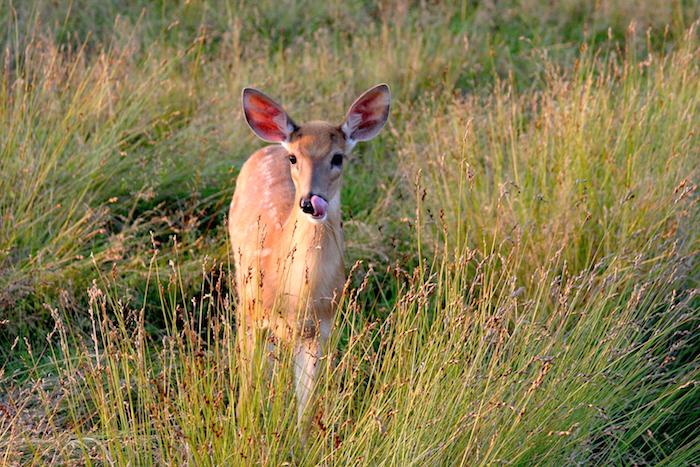
White-tailed deer are highly visible at Shenandoah National Park in fall/NPS
Shenandoah National Park, Virginia
Best bets: Black bears, raptors, white-tail deer
In Shenandoah the fall wildlife viewing is as rewarding as the leaf-peeping. Bears, deer, and migratory birds are all visible if you take the time to look.
Many folks come to Shenandoah specifically to see the black bears. The many old apple orchards established by homesteaders before they left for creation of the park attract bears, so be careful while you’re hiking.
The park’s white-tail deer seem almost tame, but they’re not. A doe will protect her young as ferociously as a grizzly sow does, so give them space. You often can spot them congregating in the fields by Skyline Lodge. Black bears and bobcats hide in the forest, and are harder to see. Coyotes, an adaptable predator not native to the area, are moving eastward.
Scan the forest for wild turkeys when you’re out hiking, though they are wary. Keep your eyes on tree trunks, too, for pileated woodpeckers with their flashy red crowns.
Resources:
South
Buffalo National River, Arkansas
Best bets: Elk
Though you might not naturally associate a river-based park with land-based wildlife, the forests and fields of Buffalo National River in Arkansas are home to about 500 elk. During the rut in October and November a good place to view these majestic animals and catch the bulls bugling is the Boxley Valley.
Resources:
Cumberland Island National Seashore, Georgia
Best bets: Song birds, raptors, pelicans, turkeys
It takes a ferry to reach, but this island park off Georgia’s coast is a favorite stopping point on the Atlantic Flyway: more than 335 species of birds have been recorded at Cumberland Island National Seashore. Pick up a birding list at the visitor center at St. Mary’s before boarding the ferry.
Roseate spoonbills and even white pelicans can often be seen from the boat on the way to the island. Once on the island, the freshwater pond areas provide excellent rookeries for wood storks, white ibis, herons, and egrets. In the forest canopy you’ll spot warblers, buntings, wrens, and woodpeckers.
On shore you may see osprey, peregrine falcons, and occasionally bald eagles and golden eagles. Wild turkeys are plentiful on the south end of the island where the ferry lands. They’re protected, so they’re not so skittish.
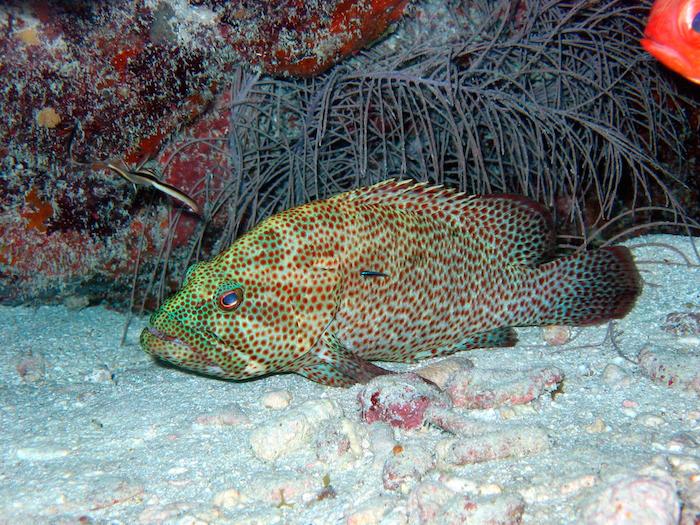
With mask, snorkel, or air tanks, you can spot wildlife -- such as this Red hind -- beneath the surface of Dry Tortugas National Park/NPS
Dry Tortugas National Park, Florida
Best bets: Raptors and songbirds, grunts, groupers, and parrotfish
At Dry Tortugas fall migration is more prolonged than spring migration, and not as influenced by weather. Large flights of raptors are common during September and October into late November.
According to park officials, “A scant assortment of water birds, most notably gulls and terns, winter in the area.” You’ll also see hundreds of warblers and other songbirds stopping to rest and refuel here.
The island is a favorite refueling spot for raptors like Peregrine Falcons and Sharpshinned Hawks; they use the songbirds for food. It might be disconcerting to see a Peregrine Falcon pick off the Blackpoll Warbler you just identified, but such is the circle of life. The falcons know a good hunting spot in the fall just as well as the birders do.
You’ll also likely spot Double- crested cormorants, Ruddy turnstones, Royal terns, and Laughing gulls.
Don’t miss the snorkeling either, since you’ve traveled all this way. Beneath the water is a colorful world, as the coral reefs here attract such species as yellow smallmouth grunts, Red groupers, Stoplight parrotfish, and Goliath groupers.
Resources:
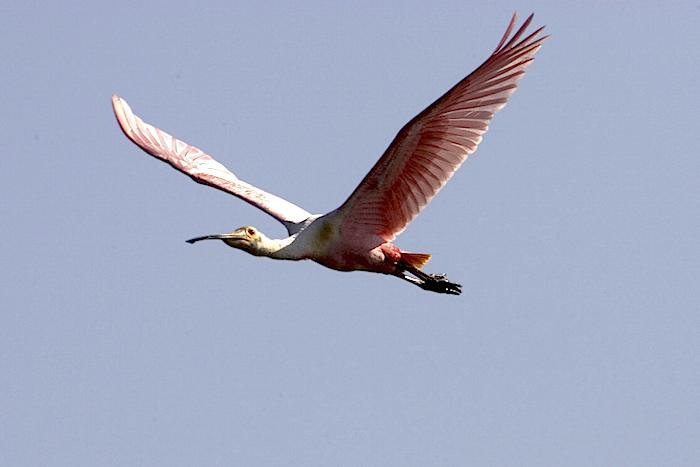
Birds, such as this Roseate spoonbill, are among the most visible wildlife in fall at Everglades National Park/NPS, Rodney Cammauf
Everglades National Park, Florida
Best bets: Raptors, wading birds
Wildlife in the Everglades is easier to spot in the fall due to the arrival of the dry season: from December through April wildlife congregates around waterholes.
The park is renowned for its birdlife, with more than 350 species counted, and many head to the park during the dry season to hang out and nest.
In fall, patient birders might be rewarded with a sighting of a rare Short-tailed hawk. Only about 50- 100 of these raptors can be found in the Everglades, from October to late February, so you have to be in the right place at the right time.... and be lucky.
Other common species include Pied-billed grebes, brown pelicans, Double-breasted and Anhinga cormorants, Great blue herons, Little blue herons, Black-crowned night herons, White ibis and a variety of ducks and shorebirds.
Resources:
North
Glacier National Park, Montana
Best bets: Mountain goats, bighorn sheep, raptors
Glacier seems to have almost every large mammal from elk to black bears, grizzly bears to moose. More frequently seen than the grizzlies, though, are the snow-white mountain goats that thrive on the steepest of slopes along the Continental Divide.
These animals, with their trademark goatees, can often be seen in the alpine meadows along Logan Pass, and even on the trails to the Granite Park and Sperry chalets. Sometimes you can spot bighorn sheep on the cliffs along the Garden Wall, which follows the divide through the park.
Glacier is a large park surrounded by public land, and was created early enough (1910) that it protects many of these animals. With a lot of luck, you might see a wolf, mountain lion or lynx. Look at the park’s mammal checklist to know exactly what to watch for.
Fall also is a great time to see bird migrations in Glacier. Watch for golden eagles migrating along the Continental Divide fly-way in mid-October. These big birds fly south from Alaska and Canada along the west side of the Continental Divide. They’re visible from Mt. Brown Lookout on the west side of the park. It’s a steep hike (5.3 miles one way), but worth it to view hundreds of golden eagles headed south.
Resources:
Sleeping Bear Dunes National Lakeshore, Michigan
Best bets: Waterfowl
Diving ducks, grebes, and loons head south in massive numbers once late September arrives. Tens of thousands of Red-breasted Mergansers will pass by the Manitou Islands of Sleeping Bear.
Birders need to have a good spotting scope and the tenacity to stand on a wind-swept Lake Michigan bluff in October, but the sight of a Red-throated Loon makes it worthwhile.
Resources:
Wildlife checklists and viewing guide
Theodore Roosevelt National Park, North Dakota
Best bets: Bison, elk, feral horses
Elk, bison, and feral horses can be seen if you visit Theodore Roosevelt National Park in western North Dakota this fall.
Campers in the Cottonwood Campground in the South Unit often are surprised by bison meandering through the campground. They graze the nubs of grass, and rub against the cottonwood trees’ thick trunks.
If you’re looking for elk, park officials suggest you look in the open grasslands in the Buck Hill area, or in the southeastern quarter of the park, which is visible from Interstate 94. These animals can be seen early and late in the day. Pronghorn antelope can be hard to spot in the North Unit, though, and only somewhat easier to notice in the South Unit, near its northern border.
Resources:
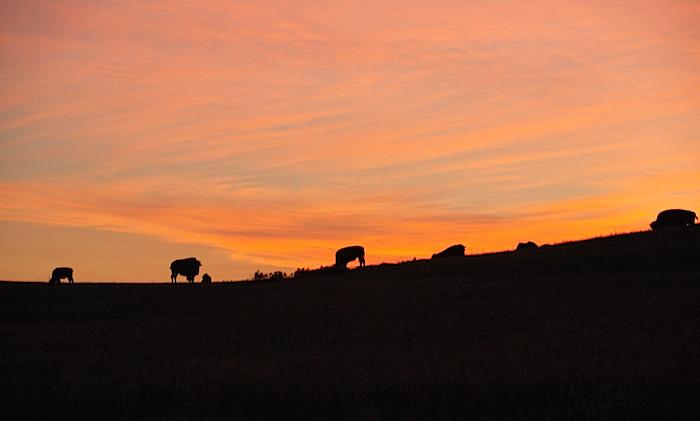
Bison, a main attraction at Yellowstone, also call Wind Cave National Park in South Dakota home/NPS
Wind Cave National Park, South Dakota
Best bets: Bison
The highlight of a visit to Wind Cave is going underground into its miles of caves. But don’t ignore the surface if you want to see some bison, and perhaps a black-footed ferret, or elk.
These animals, as well as pronghorn antelope, were restored to Wind Cave’s landscape by conservationists. While they all once roamed across the prairies here, by the early 1900s most had been eradicated by hunters.
Now, though, bison are commonly seen across the park. Just be careful when driving, though, for after sundown the bison can blend right into the dark, and you don’t want to hit them.
Black-footed ferrets, once on the brink of extinction, have recovered to a large degree through captive breeding and a return to their natural habitats, such as the prairies at Wind Cave.
Check with park staff during your visit to see if there will be any campfire talks about ferrets, or night hikes to try to spot them.
Resources:
West
North Cascades National Park, Washington
Best bets: Raptors
Watch for raptors as they head south from Alaska at North Cascades National Park. Ross Lake and Lake Chelan national recreation areas also sit along the flyway for birds of prey like the Sharp-shinned hawk en route to the subtropics.
Grizzly bears, wolves, mountain lions, bighorn sheep and mountain goats all live in the North Cascades, but are difficult, if not impossible, to spot. Check with the visitor’s center for recent sightings.
Resources:
Point Reyes National Seashore, California
Best bets: Waterfowl, shorebirds, sea lions, Tule elk
Point Reyes has the wildlife trifecta: marinelife, birdlife, and charismatic megafauna, aka elk.
Check out the fall migration in October by visiting Drakes Estero at Point Reyes. The park’s coastal location and its wealth of unspoiled habitats, estuaries, grasslands, coastal scrub and forest all attract many migrating and wintering birds.
On foggy days during the fall migration, unusual songbirds, warblers, and grosbeaks may be seen near the Point Reyes Lighthouse, according to park officials. Another good fall birding spot is the Olema Marsh, where migratory water birds come to rest.
Nearly 490 species of birds have been spotted at Point Reyes, making it the unofficial champion of bird diversity in the National Park System.
The peninsula is a geographic magnet of sorts when it comes to birds on the Pacific flyway. The shore itself attracts a wide variety of fowl, shorebirds, with rarities often showing up.
Look for Tule elk and hear them bugle once you’re done birding for the day. Look and listen for elk in the Limantour/ Glenbrook area, and in the grasslands above Drakes Beach.
Want to spot marinelife? Sea lions might be seen and heard year-round at the appropriately named Sea Lion Overlook near the Lighthouse Overlook parking area, while harbor seals can be found in Tomales Bay and Drakes Estero.
Resources:
Grand Teton National Park, Wyoming
Best bets: Elk, bison, black bears, pronghorn, white pelicans, raptors
The folks at Grand Teton help you watch wildlife in the fall by publishing a two-page flyer on where visitors can find animals. For example, the lush meadows nudging up along the northern shores of Jackson Lake attract mule deer and elk. In Willow Flats, a marshy expanse right behind the Jackson Lake Lodge, you often can spot moose and elk.
Pronghorns, similar to antelopes and the fastest land animals in North America, might be seen at the southeast end of Jenny Lake or, better yet, along the sagebrush flats along the Snake River and surrounding Mormon Row.
In early September, the Moose-Wilson Road is very reliable for spotting black bears, as they come to feast on the tasty hawthorn berries. The bruins are so fixated on gorging themselves that they pretty much ignore the cars on the road. Just remember that they’re wild bears and keep your distance.
The Oxbow Bend stretch of the Snake River also is famous for its bird-life. White pelicans, trumpeter swans, osprey, and even bald eagles are often seen. Otters occasionally frolic on the riverbanks here, and it’s a natural spot for moose.
Resources:
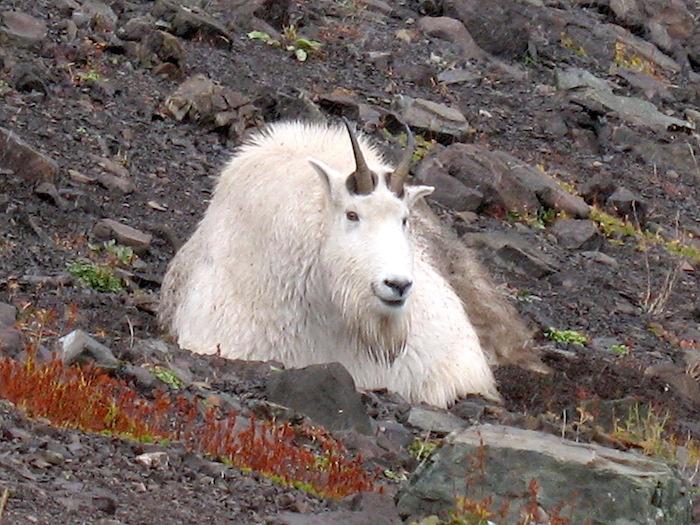
Mountain goats aren't native to Olympic National Park, but are visible/NPS
Olympic National Park, Washington
Best bets: Roosevelt elk
In Olympic, the Hoh Rain Forest is an excellent place to see Roosevelt elk. These animals don’t migrate, but prefer to stay in the Hoh area year-round and band together in herds of around 20 females and calves. September is a great time to hear the bulls bugle.
The park also has a sizeable population of mountain goats, a non-native species. To glimpse some, head to the high country, particularly along the trails surrounding Hurricane Ridge. They can be particularly dangerous during the fall rut, which extends into December, so watch from a distance.
With its long, rocky coastline, you might also get a chance to glimpse some marine life on its migratory comings and goings. The coast just happens to lie along the migratory path of both California and Steller’s sea lions, according to park officials, en route to foraging areas in the Strait of Juan de Fuca.
Sea lions feed in the coastal waters in the late summer and early fall.
“They haul out in masses on the abundant offshore rocks, amiably alongside their larger cousins. These whiskered creatures are often visible on the islands off the coast of Cape Flattery and Cape Alava, arriving in late summer or early fall, and often staying through spring,” park biologists say.
Resources:
Rocky Mountain National Park, Colorado
Best bets: Elk, bighorn sheep, raptors
Elk in Rocky Mountain were hunted extensively and almost vanished by 1890 as people settled the Estes Valley. But animals transplanted from Yellowstone, just before the establishment of Rocky Mountain National Park in 1915, rebuilt the herds. Predators such as wolves and grizzly bears were hunted extensively in the area, which helped the swift growth of the elk population.
Currently, the elk population in the park fluctuates dramatically from summer to winter. More than 3,200 elk roam the park in summer, though that number can dwindle to 600- 800 during winter as elk migrate to lower elevations outside the park.
The best places to view and hear elk are Moraine Park, Horseshoe Park, and Upper Beaver Meadows on the east side of the park and Harbison Meadow and throughout the Kawuneeche Valley on the west side of the park.
Plan your visit for early October and take part in the 18th Annual Elk Fest. This affair (Oct 3-5) offers everything from science on these big ungulates and elk bugling contests to bus tours to view elk.
Rocky Mountain also has spectacular fall vistas and great avian migrants. Raptors follow the ridges, sometimes migrating simply from higher elevations down tributary ridges to lower areas for the winter. Watch for resident Red-tailed Hawks as they chase other hawks out of their territories as they pass through.
When leaves are shed in late fall, it’s a great time to hunt for some of the boreal residents of the mountains like the American Three-toed Woodpeckers and Gray Jays.
Resources:
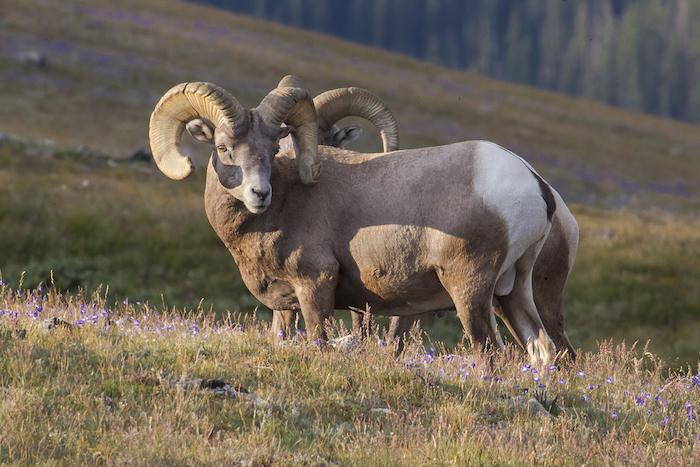
Bighorn sheep vie with elk for the most visible wildlife at Rocky Mountain National Park in fall./NPS, Ann Schonlau
Yellowstone National Park, Wyoming
Best bets: Bison, elk
Yellowstone overflows with wildlife — moose, elk, pronghorn, bison, wolves, grizzlies, black bears and so much more. So much wildlife exists in Yellowstone, and so much is highly visible, that the park probably should have trademarked the phrase “Bear Jam.”
The Hayden Valley is highly reliable for bison sightings, as is the Lamar Valley in the northeastern corner of the park.
Elk even hang out all around park headquarters at Mammoth Hot Springs. In the fall this can be dangerous for visitors, as bulls in rut have charged visitors and vehicles. You can observe them, from a safer distance, along the Madison River that parallels the road running from West Yellowstone to Madison Junction.
Head out to the Firehole, Madison, and Gibbon rivers to look for white pelicans, mergansers, and possibly trumpeter swans. In treetops overlooking the lakes, osprey, common loons, and even bald eagles are seen. In early November, look for tundra swans on the water and trumpeter swans on the rivers.
Resources:



Comments
Great Smokies also has some salamanders that are only found in that area. My brother showed us several by knowing where to look.